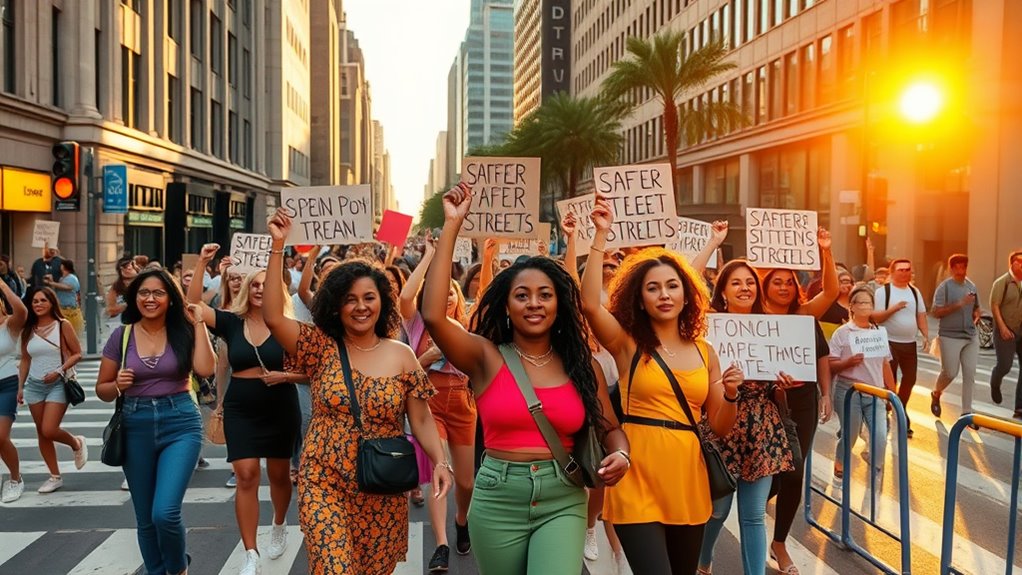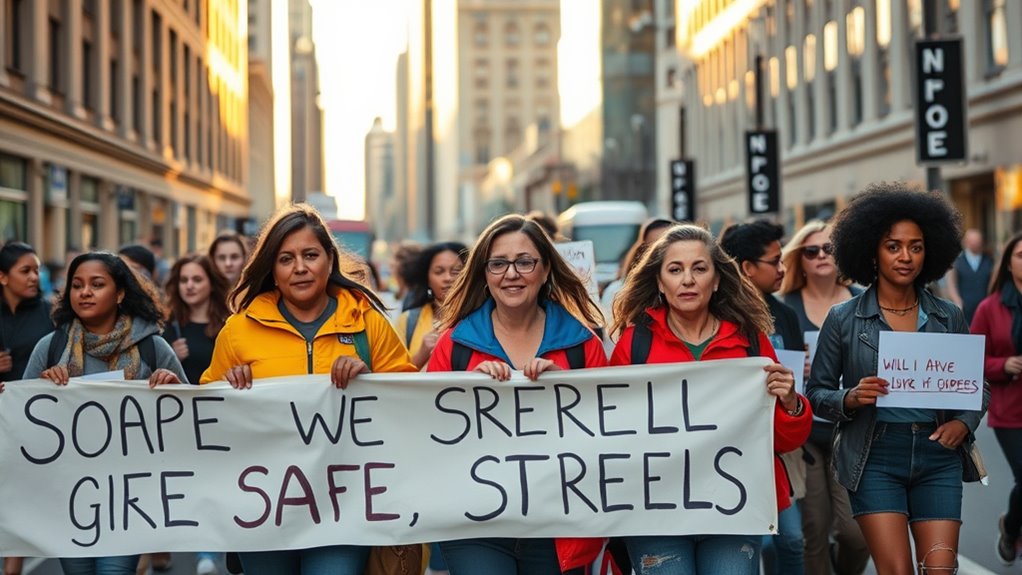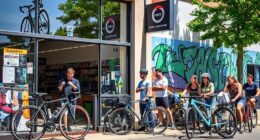Women activists are leading critical efforts to make streets safer and more inclusive for everyone. They mobilize communities, influence policymakers, and push for tangible safety upgrades like better crossings and protected bike lanes. Their work emphasizes social equity, addressing risks faced by vulnerable groups. By advocating for evidence-based policies and community engagement, they’re transforming urban spaces into safer environments. Discover how their leadership continues to shape a more equitable and secure future for all street users.
Key Takeaways
- Women activists lead community efforts to push for infrastructure changes like protected bike lanes and pedestrian crossings.
- They highlight social equity issues, advocating for marginalized groups such as women, children, and seniors.
- Strategies include organizing workshops, social media campaigns, and coalition-building to influence policy reforms.
- Women-led groups partner with authorities to promote evidence-based safety improvements and stricter traffic enforcement.
- Their advocacy fosters safer, more inclusive streets, demonstrating resilience and shaping future transportation policies.

Have you ever wondered who’s truly driving change for safer streets? It’s often women activists who are at the forefront, pushing for meaningful reforms that prioritize safety for everyone. These women understand the daily risks faced by pedestrians, cyclists, and vulnerable road users, and they refuse to accept the status quo. Instead, they mobilize communities, influence policymakers, and challenge outdated infrastructure that puts lives at risk. Their advocacy isn’t just about raising awareness; it’s about creating tangible change that saves lives and makes streets accessible for all.
Women activists are leading the charge for safer, inclusive streets that save lives and prioritize vulnerable communities.
Women leaders in this movement recognize that transportation safety isn’t just a matter of infrastructure but also of social equity. They highlight how marginalized groups, including women, children, seniors, and people with disabilities, bear the brunt of unsafe streets. By speaking out, they draw attention to disparities that often go unnoticed—such as the lack of pedestrian crossings in underserved neighborhoods or the absence of protected bike lanes. Their voices amplify the call for inclusive planning that considers the needs of all users, not just drivers or car owners. This approach shifts the conversation from convenience to necessity, emphasizing safety as a fundamental right.
Many women advocates are also harnessing the power of storytelling and community organizing to rally support. They share personal stories of near-misses, accidents, and tragedies to humanize the issue and foster empathy. Through workshops, town halls, and social media campaigns, they build coalitions that pressure city officials and transportation agencies to prioritize safety improvements. Their activism often results in concrete changes—such as lowered speed limits, expanded sidewalks, or new bike-sharing programs—that directly impact daily life. These efforts demonstrate that advocacy isn’t just about words; it’s about action that transforms streets into safer spaces. Additionally, integrating Cultural Intelligence strategies can enhance their ability to connect with diverse communities and foster greater inclusivity in advocacy efforts.
Furthermore, women-led advocacy groups frequently partner with other organizations to push for policy reforms. They lobby for legislation mandating safer street designs, increased funding for pedestrian infrastructure, and stricter enforcement of traffic laws. Their leadership ensures that safety remains a priority in urban planning and transportation policies. Their work often involves engaging with community input to better understand local needs and barriers, which strengthens their campaigns and results. Incorporating evidence-based practices can further strengthen their initiatives and ensure that safety measures are effective and sustainable. This reliance on data-driven approaches helps in making informed decisions that have a lasting impact. By holding officials accountable, they make sure that safety considerations are embedded into long-term development plans rather than added as afterthoughts. Their persistent efforts show that change is possible when women take the lead, shaping policies that protect vulnerable populations and foster healthier, more equitable communities.
In essence, women advocating for safer streets are not just reacting to danger—they’re proactively shaping the future of transportation. Their work embodies resilience, innovation, and a deep commitment to justice. As they continue to lead the charge, they prove that when women step up as advocates, streets become safer, more inclusive, and more livable for everyone. Recognizing the importance of public engagement can further amplify their impact and ensure community voices guide sustainable safety solutions.
Frequently Asked Questions
How Can Men Support Women-Led Street Safety Initiatives?
You can support women-led street safety initiatives by listening actively and amplifying their voices. Volunteer your time or resources to help organize events or campaigns. Speak out against harassment and unsafe behaviors, showing solidarity. Share their messages on social media to raise awareness. Offer your skills, like photography or advocacy, to boost their visibility. Your active involvement demonstrates commitment and helps create safer, more inclusive streets for everyone.
What Funding Sources Are Available for Women-Led Advocacy Groups?
Think of funding sources as hidden treasures waiting to be opened. You can tap into government grants aimed at community safety, reach out to foundations supporting gender equity, or explore crowdfunding platforms to rally public support. Local businesses and philanthropists might also back your cause if you present a compelling case. With persistence and strategic outreach, you’ll find the resources needed to empower women-led initiatives and make streets safer for everyone.
How Do Cultural Differences Impact Women’s Street Safety Efforts?
Cultural differences profoundly shape your efforts to improve women’s street safety. In some societies, traditional gender roles may restrict women’s mobility or voice, making it harder to organize and advocate for change. You might face resistance or lack of support, but understanding local norms helps you tailor your strategies effectively. Respecting cultural nuances while promoting safety encourages community buy-in and sustainable progress, ultimately empowering women and fostering safer streets everywhere.
What Are the Long-Term Goals of These Women-Led Initiatives?
You want to understand the long-term goals of women-led initiatives for safer streets. These efforts aim to create lasting change by improving security, fostering community trust, and empowering women to participate actively in urban safety. You’ll see them advocating for policy reforms, raising awareness, and building inclusive environments. Ultimately, these initiatives seek to guarantee that women can navigate public spaces confidently and safely for years to come.
How Can Individuals Get Involved in Promoting Safer Streets?
You can get involved in promoting safer streets by joining local advocacy groups or attending community meetings. Volunteer for awareness campaigns or organize neighborhood patrols to increase visibility. Use social media to raise awareness and support policies that improve safety. Talk to your neighbors about concerns, and advocate for better lighting, crosswalks, and traffic calming measures. Every action counts, and your participation helps create a safer environment for everyone.
Conclusion
You can see how women are transforming streets into safer spaces, proving that advocacy drives real change. Did you know that women-led initiatives are 40% more likely to prioritize safety features? By supporting and amplifying their efforts, you help create communities where everyone feels secure walking or biking. Keep pushing for change—your voice matters in building safer streets for all, proving that collective action truly makes a difference.









